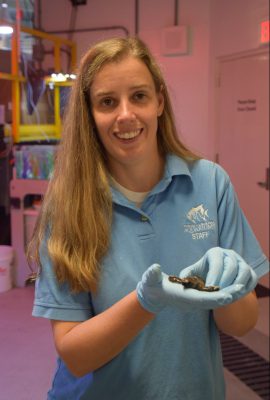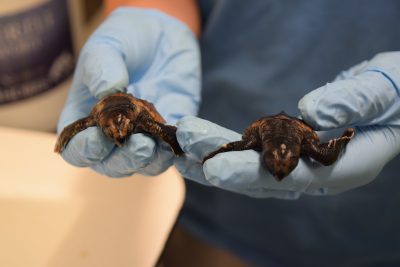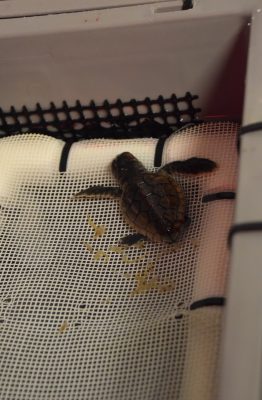
PINE KNOLL SHORES — Every summer in the back halls of the North Carolina Aquarium here, several large tanks become hospital wards for injured, sick or weak baby sea turtles brought in from local beaches. The aquarium welcomed the first five hatchlings of the season last week, with dozens more expected in the coming months.
Michele Lamper, an aquarist at the aquarium, runs the rehabilitation program, which seeks to treat and release juvenile sea turtles back into the ocean. She works on the project with the state Wildlife Resources Commission, which makes decisions regarding sea turtles on land.
Supporter Spotlight
Most sea turtle species, including loggerhead, Kemp’s Ridley and green are endangered. Lamping said saving as many babies as possible is important because only one in a thousand will make it to adulthood. Saving and releasing a turtle, she said, still means that turtle might die, but it could increase the chance of another turtle surviving.
“Once they get to the water, then it’s up to nature, and most of the time it will get eaten,” Lamper said. “If he happens to be the one that gets eaten and it happens to save another one who does reach adulthood, then okay, great. We’re still accomplishing.”
Sea turtles come to the aquarium for a variety of reasons between May and October, their nesting season. Some are injured by predators, buried in their nest or are found moving away from the ocean after following a light source in the wrong direction.
This year’s nesting has been record-breaking, with about 1,520 sea turtle nests identified along the North Carolina coast. Of the nests, only four are Kemp’s Ridley and 17 are green. The rest belong to loggerhead turtles. Since the arrival of the initial five turtles, Lamping now has a dozen under her care.

With such large numbers of nests, Lamping expects more hatchlings to arrive. The aquarium, she noted, has never had less than a hundred in a season.
Supporter Spotlight
The five hatchlings, which are all loggerheads, represent a diversity of ailments afflicting baby sea turtles.
Two of the turtles were found on Atlantic Beach with little energy. Their shells and flippers were still soft and folded. Too weak to live in water, the turtles were placed by Lamping into a dry bucket with a moist towel upon arrival, but Lamping said they’re now swimming and eating on their own.
Two more turtles were found, dehydrated, at the bottom of a nest in Emerald Isle. A ghost crab had dug a hole in their nest, making it impossible for them to climb out. They also suffered from folded left flippers that Lamping plans to correct with physical therapy, including flipper rotations and stretches. One of the turtles was also taking antibiotics for an eye infection. Lamping said the turtles are also swimming and eating on their own.
The last turtle was found in Pine Knoll Shores after he made it out to the ocean, but was washed back to the beach. Lamping said the turtle hasn’t been able to eat on his own since he was found, and is not optimistic about his survival.
“We’re doing a mixture of force-feeding and we also have some fluids on him since he hasn’t been able to turn it around,” she said.

There are a variety of treatments for the turtles, including vitamins in their food, plankton and injectable fluids. Lamping said most of her time is spent flushing out wounds and keeping the turtles clean.
“I clean them every day. I flush them every day,” she said.
Before they are released back into the ocean, a vet checks on all of them to make sure they’re swimming, diving and eating properly. Most will be released back. Lamping said some may need additional time to strengthen up or may have to stay in captivity if they are unable to live in the wild.
The turtles stay in the facility anywhere from a couple of days to months, depending on the illness or injury. Some turtles simply hatch too early and are released within days if they still have their yolk sacs, a nutrient source, attached. Those that do not will be released in October, when they are stronger.
Lamping said that for those turtles, the aquarium cannot simply release the turtles onto the beach after a few days because they won’t have yolk sacs to nourish them in waters near the shore, which don’t have much food. Instead, the aquarium waits a couple of months, until they know the turtles are healthy, can catch their own food and can swim proficiently, releasing them into the ocean with a higher chance of survival.

Ten to 15 healthy turtles are selected to stay in the aquarium or are used as part of an educational loan program, where they are sent to aquariums all over the country for one to three years, after which they are released into the ocean. Lamping said programs like these help educate hundreds of visitors every day.
Lamping said there are several human factors that can contribute to the obstacles hatchlings face. For example, lights on beaches lead hatchlings away from the ocean and can lead to their deaths at the hands of ghost crabs or the scorching sun. Tire marks that run parallel to the water and holes left by beachgoers can trap the babies, leaving them vulnerable to prey and dehydration.
She recalled an incident when a group of hatchlings were found dead in tire tracks.
“It was probably enough time, enough heat and sun,” she said, “that it killed them.”







